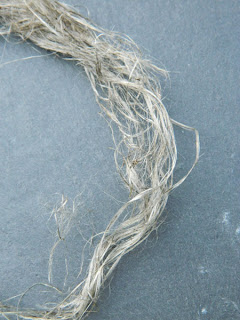
Plants were often one of those key those raw materials that supplied our ancestors and in fact, still supply us with the basics of life. The study of how various peoples have traditionally used plants for food, medicine, utilitarian needs, sacred purposes, and so on is called ethnobotany. It is one of my passions because it combines two of my life-long loves - plants and archaeology/anthropology.
One of the things you will find in ethnobotanical references that modern peoples give little thought to is fiber and cordage plants. While we can visit our local department store for thread, rope, or even fabric whenever we want, our ancestors had no such resources. They made all the ropes, cords, and cloth that they needed. While certainly there are some animal sources like wool and sinew that were used for these purposes, plants provided the bulk of the fiber raw material used.
Why should this be so important and so universal a need? Think of what a cord, rope, or piece of fabric meant. A bow string, net or snare for hunting and fishing meant food. Fabric clothed and so warmed or protected our bodies. Even if you wore skins and furs, you probably stitched them in some manner to better fit and cover your form. Ropes and cords lashed our shelters together, made it possible for us to better haul, pull, or carry items. Ropes or other bindings kept our animals from wandering away. Fibers and the cordage were indeed a key element of survival.
 |
| Stinging Nettle Fibers |
Stinging Nettle
Stinging nettle is one of the great plants of the world. Like the dandelion, it is much maligned yet it gives us so much. The leafy parts of the stinging nettle provide a nutritious food and a host of medicinal uses.
But the nettle has also been used in Europe since ancient times (Bronze Age at least), for fiber and cloth. The fiber from stinging nettle is linen-like. In the raw fibers I collected today, it was by far the most fine and luxurious to the touch.
 |
| Jew's Mallow Fibers |
Jew's mallow or "molokhuiya" is a popular potherb and vegetable in the Middle East and it too has some medicinal usage. The fiber from this plant is the main source of jute. Jute is a coarse fiber. It is indeed "sack cloth." But since it has so many utilitarian uses, it is second only to cotton in its important vegetable fiber source.
Like linen and variety of other fiber plants, jute is normally "retted" or soaked in water until the plant fibers can be worked free. I didn't ret the plants and my plants were not dry so the fibers were rather hard to peel from the stems. But it is clear that the fibers were the most coarse I collected today.
 |
| Dogbane Fibers |
Dogbane is a New World plant that despite its toxic nature was a medicinal plant used by the Native Americans. But its use as a fiber plant gives dogbane one of its more common names, "Indian Hemp." Earlier this year I attended a workshop that focused on Haudenosaunee (Iroquois) cordage making. If you would like to see photos from that workshop or read more on that topic, please see my article on it.
Dogbane is an amazingly strong and fine fiber. I find it relatively easy to peel from the stems - no retting required. This native and hardy perennial supplies fibers that can be worked into a variety of cordage needs.
